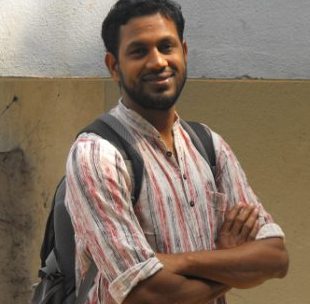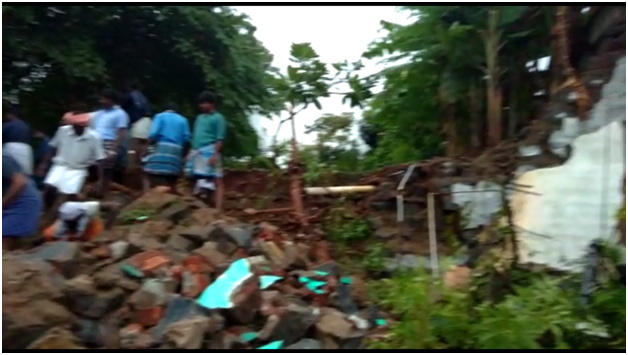Narayanan M Sankaran
(Translated from Malayalam by Joseph Antony)
 ‘Onam is the National festival of Malayalis’. It is a sentence one learns or is rather made to learn to write and speak from school days onwards. During my childhood, and for many years after that, Onam stood for exciting times for the sole reason that it meant a few days of leave from school during which one could roam hither and thither. Onam never appealed to me as a cultural festival simply because none of the symbols and myths associated with it had any connection with the traditions and beliefs of the community I am a part of. I have felt my community had been always side-lined by the Kerala society, as if it were an outlier to culture and civilization.
‘Onam is the National festival of Malayalis’. It is a sentence one learns or is rather made to learn to write and speak from school days onwards. During my childhood, and for many years after that, Onam stood for exciting times for the sole reason that it meant a few days of leave from school during which one could roam hither and thither. Onam never appealed to me as a cultural festival simply because none of the symbols and myths associated with it had any connection with the traditions and beliefs of the community I am a part of. I have felt my community had been always side-lined by the Kerala society, as if it were an outlier to culture and civilization.
The nostalgic myth associated with Onam, as far as we are concerned, is a story of disappropriation and slavery. Thus, whenever I hear that Onam is the cultural festival of all and sundry in Kerala, I feel a certain discomfort: How did Onam, a festival observed by a select few, become the festival of everyone? If it were indeed everyone’s festival, why was it celebrated with all pomp and glory at a time when thirty odd Adivasis died of starvation in Palakkad and Wayanad during one Onam season? Does it not go to show that Adivasis are not a part of Kerala society? What we can see here is the blatant imposition of a savarna festival on others under the garb of secularism by the savarna society of Kerala.
One of the many arguments in favour of considering Onam as a national festival is that it’s a harvest festival. But we need to ask—who were the harvesters? And who really gained from the harvest? Is it the kudiyan (serf) who worked tirelessly from dawn to dusk or the Janmi (feudal lord) who looked on at the bare chests of his workers as he chewed his betel quid? Who among them made Onam the national festival of Kerala? When the chores at the fields would remain unfinished, the lords of Wayanad would take advantage of the helplessness of the Adivasis and would make them work from dawn to dusk. The traditional custom of Kambala Natti is ample proof of this exploitative system.
When it becomes clear that the chores would not get over at a specified time, the janmi would allow singing and dancing in the field and, as a result, Adivasis would toil away, without any sense of time, to fill the granaries of their master. This tradition, which came to be known as Kambala Natti, was not introduced to alleviate the Adivasi’s hunger, but to line the pockets of his master. One of the memories of an Adivasi community about such a harvest festival goes thus: “We do not have any food, no curry, nothing to eat. We have to cross the orchards and fields of the new inhabitants to go to the distant forest in search of tubers. And while we would be at it, digging for the tubers, they would come and shoo us away. The granaries of our master would be brimming over with grains at these times. We could be made to carry those grains—only to burn it—to make room for new grains.”1 This is how the Adivasis lived during the harvest festival. How would then such a community, which sacrificed itself to fill the granaries of the feudal lords, be part of Kerala’s harvest festival? There is an inseparable bond between the Adivasi and the soil. The savarnas have only exploited them always.
The ways in which Adivasis were exploited can be found in the memoirs of C.K. Janu, who had to wage several struggles to gain a shred of land for the people of her community: “If you get into the field to work, by noon you will get some rice gruel. We cook it ourselves. We get some salt and chillies with the rice gruel which is served in a hollow dug in the ground. There would be more of water than rice in it. When there aren’t enough cattle, we’d be made to pull the yoke as well. While pulling the yoke, it’s very hard to pull one’s feet forward in the slush. It would feel as if your feet were sinking into a hellhole. When rain beats down, we wear hats made of spathes of areca. If you look at the water droplets falling off its top edge, you wouldn’t feel the pangs of hunger.”2
So is the harvest festival of Kerala all about the rulers filling their bellies and enjoying at a time when landless people fated to be slaves work like animals? Also, it’s illogical to claim that the harvesting is done in the month of Chingam3. In Kerala, monsoon farming starts at around the months of Idavam–Mithunam4. Which crop do these people sow that yields in just a month? If it’s paddy farming, how is it possible to offer paddy stalks in Hindu temples such as Guruvayoor and Sabarimala on the 10th of Thulam5? From this I infer that the dominant portrayal of Onam as a harvest festival is a sham concocted by the savarnas to portray that the serfs who worked in the agricultural lands were also a part of this festival.
Another story that adds to the charm of Onam is that it’s the celebration of the return of King Mahabali under whose rule Keralites didn’t know caste or religious distinctions. But if things were alright with the society, then why would ‘Maha’ Vishnu, manifesting in the form of a Brahmin child (with extraordinary powers), destroy its peace? It also prompts the question as to whether this was fuelled just by the jealousy and fear of the ‘devas’, as described in the puranas, or the intent was to create class distinctions in the society? Anyway, I’m not going to question the supposed motives behind this move. However, we need to know what’s there to celebrate in this story of betrayal. Some people here argue that the Onam story is just a myth. If that were the case, why would a democratic government make a national festival out of a myth?

As Raghavan Payannad opines, a mythic story is formed to offset doubts and dissatisfactions about a society’s traditions and customs. We may have to very well see the Maveli (Mahabali) myth along these lines. For certain communities this mythic story is necessary to perpetuate their varna discriminations. Above all, the Maveli story is that of a betrayal. Is there any other religion like Hinduism which celebrates the story of a betrayal? The interesting part is that even in this myth, the Kerala society talks only of a select community’s story of Maveli. It’s difficult to comprehend why the Maveli stories among the subaltern castes are not being considered. This just goes on to show that Kerala society has always sided with savarna history and avarnas have been always outside its fold.
There are several stories about Maveli among the Adivasi communities in Kerala. The Adiyar community in Wayanad has one such story to narrate. What we can perceive from their story is the pain of King Maveli getting betrayed and killed by upper-caste landlords. Not only did they murder Maveli, they also grabbed the community’s land and forced them into slavery. The land policies of the erstwhile government that declared Onam as a national festival and the attitude of the feudal lords are pretty much the same—both enslaved Adivasis in their own soil and usurped their land. The story of the Adiyars goes thus:
Long ago, we also had our time. The time of Maveli Manduva Theyyam. There were no castes or sub-castes and the times were peaceful. Once three lords came from the sky to meet Manduva Theyyam. Maveli received them as his guests. But when Maveli came back after resting, he could not find the mannu (soil/land) he had been saving safely until then. He enquired after his guests about this and an argument ensued. Finally, it was decided that a test would be conducted. Both parties will take a dip in a river—the lords in the lower banks and Maveli in the upper banks. If the lords had stolen the land, the water will get muddied and will flow up. If the mannu were with Maveli himself, the muddy water would flow to the lower banks. Maveli agreed to the conditions.
Both parties then took the dip and the muddy water flowed to the lower banks. The enraged lords hit Maveli with a vessel of slaked lime and murdered him. As the bereaved sat mourning their beloved king, the lords from the sky possessed their land and made them their slaves6. Are the secularists in Kerala then trying to say that a people who fell prey to this betrayal should forget all their losses and celebrate Onam? Non-Adivasis say that the Onam myth should not be taken at face value. But if Kerala society, which celebrates Onam based on just a myth, were to consider the story of Adiyars, it’d be forced to answer a lot of their questions: They ask, where is our land? Where is the land you stole from Maveli? Why did you murder Maveli and make his wards your slaves? The ruling dispensation will be hard put to answer these questions.
Onam was declared Kerala’s national festival by the then government only after debates around land reforms started. The Kerala Land Reforms Act benefitted only a certain segment of the population. The government is celebrating a savarna Hindu festival as “everyone’s festival” after evicting a whole community from its land for the benefit of a few. That’s the reason why when a segment of the population is still waging a struggle for a shred of land and is dying of hunger, the government is celebrating Onam as everyone’s festival. I cannot, therefore, comprehend how when Kerala’s Dalits and Adivasis are getting dispossessed of their land and are ostracised from their society, this festival could become the festival of the Keralites.
~
Notes
[1]. “Nadugadiga”, K J Baby, DC Books, Kottayam: 2000
[2]. “Mother Forest: The Unfinished Story of C.K. Janu”, J. Bhaskaran (tr: N. Ravi Shankar), Kali for Women, 2004: New Delhi.
[3]. Malayalam month corresponding to the August-September period during which Onam is celebrated.
[4]. Corresponds to May-June—June-July periods.
[5]. Corresponds to the October-November period.
[6]. See “Nadugadiga”.
~~~
Narayanan M. Sankaran is currently working towards his PhD degree at the English and Foreign Languages University, Hyderabad. He hails from Wayanad district in Kerala and belongs to the Kuruma Adivasi community.
Translator’s bio: Joseph Antony is an MA student at the English and Foreign Languages University, Hyderabad. He hails from Trivandrum, Kerala.
Cartoon by Nidhin Shobhana.










